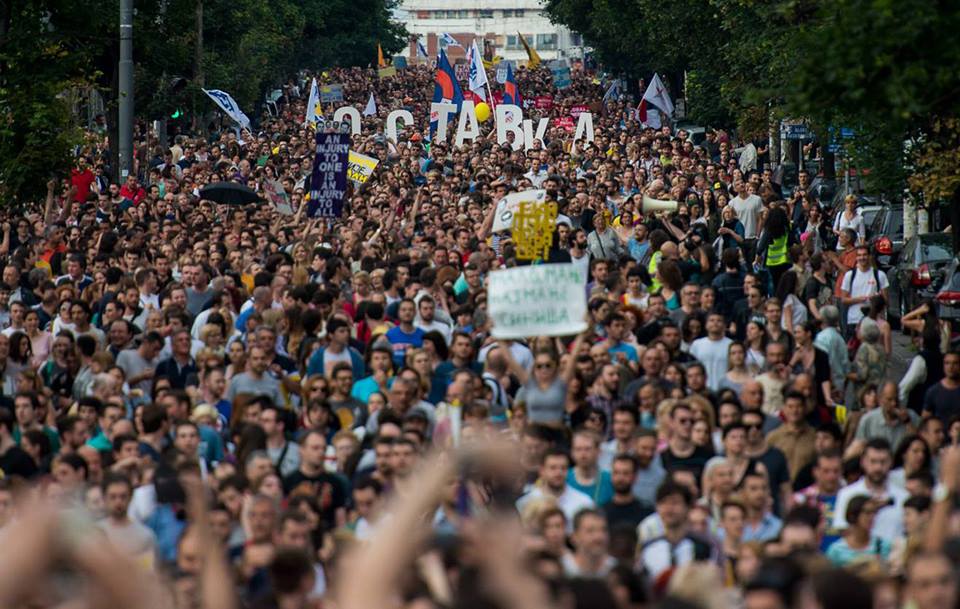
Written by Yulia Vladimirova; Originally appeared at A-specto, translated by Borislav exclusively for SouthFront
Belgrade ends up very often in international media for the past month. Indeed, something extraordinary is happening there. The city is rebelling with the energy of thousands of people, mainly young and educated. The reason for the anger and protests of citizens on the Belgrade streets, is the building project Waterfront, which has a territory of over 2 million square meters. This project is a deal between the Serbian government and the United Arab Emirates. The idea is to build a large complex with residential and office buildings, the largest shopping mall in the Balkans, a hotel, an opera house and a skyscraper on the right bank of the Sava River, between the Belgrade Fair and the Central Railway Station.
The Waterfront project was launched in March 2014 in Cannes and is worth 3.5 billion euros. Even then, there were protests against the construction of this giant-sized complex, and in the winter of 2015 after the first dig of one of the luxury buildings started, around 2,000 people gathered. One of the main initiatives is Ne davimo Beograd (a play on words between “We don’t give Belgrade” and “Don’t drown Belgrade”) that arose two years ago still with the emergence of the idea of the project Belgrade Waterfront. The movement has organized several protests against construction on the banks of the Sava before, but became famous mostly with organizing very large demonstrations with many thousands of people, in recent months on the streets of Belgrade.
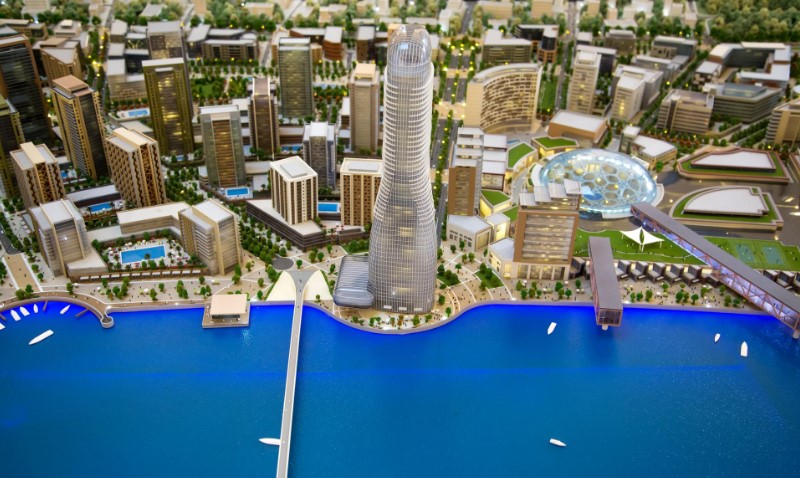
Waterfront
What caused 20,000 people to defend the city for the third time on June 11 2016 with the basic question “Ciji grad?” (Whose city?) And to jointly answer “Nas grad!” (Our city!)?
On the night of April 24, a group of masked men begins to detain people illegally and to destroy buildings and structures in the area Savamala. This is a neighborhood of arts and nightlife, that was determined to be the site of the giant building complex in the style of Dubai. The restaurant “Sava Express”, the company “Iskra” and several other buildings are destroyed. This is the turning point that turns the protests of a group of activists from Ne davimo Beograd into demonstrations with more than 20 000 people of all ages and different political views. After the night of masked destruction of buildings and kidnappings in the Savamala neighborhood, police state that they do not know anything about it.
According to Pavle Ilic, a student of sociology at the University of Belgrade and an activist in “Marx 21” which is one of the main leftist movements in which thousands of people protest, the Prime Minister of Serbia Aleksandar Vucic is very authoritarian man. When asked does the Prime Minister get along with President Tomislav Nikolic, who has a pro-Russian stance, unlike the Euroatlantic Vucic, Pavle Ilic replies that since both come from the Progressive Party of Serbia, their seemingly divergent views can not realize a real political change. That is to say, the party behaves in line of the Euro-Atlantic alliance and the typical neoliberal policies. Understandable for a party that is in the center-right with a very ugly nationalist past in 90s.
Stepping in front of the television, Vucic states he does not know who were the masked “workers”, that destroyed several buildings overnight. Thus, an enormous discontent was born and thousands of people poured on the streets and in front of the parliament, to ask the prime minister and government, “Whose city is Belgrade?”. And to answer together: “Belgrade is our city, the masks have fallen!”
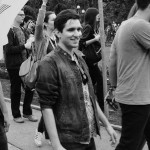
Pavle Ilic
According to Pavle Ilic, who participated in the three major protest, the government is now simply ignoring this major event. At the same time, there are demonstrations in Nis, where a year and a half ago, the prices for heating were raised and thus resistance was born. To the north, in the second largest city in Serbia, Novi Sad, a local television is threatened to be closed after the government tried to manipulate and censor it. Journalists there are protesting in support of their colleagues and are all coming together to protest in Belgrade to demand the resignation of Aleksandar Vucic.
About the strength of the protests Pavle Ilic says: “Perhaps we are witnessing a very broad movement of resistance in Serbia, relating to the preservation of public goods – public media, public space, the public housing which we do not have it because it’s all private”. Besides that, adopted is also a new law on higher education that states that a part of university fees do not have to be payed by the state. According to Pavle Ilic now everyone has to pay their own full fee. Students dissatisfied with the decisions of the government are also actively involved in the big protest.
With Pavle Ilic we converse about the way in which the media reflect the three major protest (marches are held every two weeks, the last one on June 11 had more people than the previous two, with over 20,000 people). He said that Serbia has never had a great achievement in freedom of speech, but that the situation has deteriorated significantly over the past few years. The media basically ignore the protest, as does the government. Usually they significantly reduce the number of protesters. “On our first demonstration there were about 5000 people, and they reported of 600. Opposition parties have representatives at the protests, but seek their own popularity.” And the policy of opposition parties does not differ from that of the Progressive Party, they all follow the line of neoliberal ideology. “Vucic follows a strict pro-Euroatlantic position, he is an agent of Angela Merkel. Vucic does everything the International Monetary Fund tell him. He even applies a policy of austerity in Serbia without anyone pressuring him into doing it. People who are such fanatical followers of the most undemocratic aspects of the EU actually caused our protests. The problem is that with these media and the attempts to ignore us, no one says to Vucic: “Damn it, what the hell are you talking about!”
It would be wrong to call this protest completely left. Not only Ilic convinces me of this, but also other people with whom I spoke during the demonstration. Even though it unites some people from the left, the protest in any case is not consciously left. The only big left organization is “Left Peak” a part of which is “Marx 21”. Besides them there are participants from the mainstream political opposition but also by the libertarian club who are fetishists about the free market and other movements with absolutely opposite views. There is no specific political formation that is behind this protest. That would be strange to our Bulgarian protesting disposition, where all sorts of groups bravely give themselves the label “civil society”.
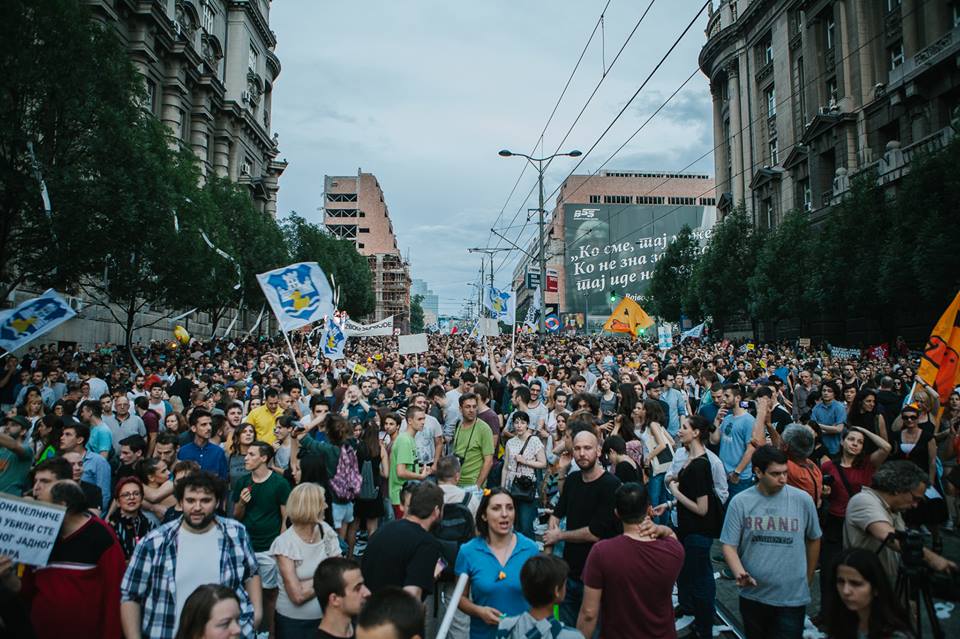
In this case, it is clear that the protest in Belgrade unites Eurosceptics, critics of the free market and inequalities, but also Euroatlantists, libertarians and those on the center-right. According to Pavle Ilic there is a slight animosity between them, for example, the libertarians are not happy with the presence of a large left wing group. However, the Belgrade protest is a great achievement and goes beyond the pathetic Bulgarian protest camp manifestations. Here, the camps are united for a common cause: to save the riverside bank of the Sava, from the onslaught of the Dubai oil business, hungry to pin giant luxury facilities at any cost and by any brutal way.
“The city is ours” is a sufficiently strong message of solidarity. It goes beyond the “Moscow-Washington” camps, beyond propaganda, beyond critics and blind supporters of the EU, beyond meaningless abstract slogans like “morality in politics” and the volatile terms like “red junk” that our “young, smart and beautiful” disseminate everywhere, with which they resemble protests of the 90s. The opposite of this – the Serbian protesters live in the present, they are up to date, because they actually are beautiful, and more importantly – they are smart!
Over 20 000 people gathered on Saturday in front of the Serbian Assembly, calling on Vucic and his government to withdraw, shouting that citizens decide the fate of the city. They said “no” to corruption and government transactions under the table with rich Arabs. Belgrade is rebelling. This city does not give up easily. By walking on the streets, you realize that Belgrade smiles with it’s slightly disheveled appearance, it’s tireless life, unpretentious beauty and credibility. You discover the forgotten grandeur of different architectural influences from the West and from the Yugoslav socialist realism. The healing of complexes is at a more advanced stage, than in Sofia.
Belgrade also impresses with it’s alternative culture, transforming the spaces from the past into new modern places, like neighborhoods in Berlin or London. In other words, it is a way to transform the dismal industrial periphery into a spectacular area for young people and local businesses. So we can see a whole neighborhood that is not located in the “Heart of the City” but in an industrial zone that instead of resting in eternal sleep, deconstructing ever more, is becoming one of the most interesting neighborhoods with interesting bars, restaurants and spaces for culture, inhabiting the former factories, warehouses, depots, etc. All this is accompanied by interesting graffiti, including absurd ones that urge us to become vegans in the Mecca of pljeskavica.
Belgrade is meaningful, colorful and youthful. Also proud. With solidarity, unity and a revolutionary spirit. At innumerable protest on June 11, I walked into the crowd to see people’s faces and I was impressed by their energy and their sincerity, which ignored the differences of old, young, green or blue hair, that someone is Russophile or Russophobe, left or right. Impressively strong were their tense bodies, their faces, people who just want justice. They want to say that public spaces are public and that they belong to the people of Belgrade. And only they can decide whether they want to construct hotels and skyscrapers, and the “delightful mall” of Arab businessmen.
Walking through the crowd, I ask protesters in the rain, why they are out here. “I’m here because I’m pissed of at the parliament and the mayor who decide everything for themselves without consulting the opinion of the people, because we are the ones who live here! And every decision affects us! To destroy things in the night with face masks – we will not accept it” says Marina Petkovic, standing before parliament.
Dragan Ivanovic also came to the protest with friends. When asked why he supports it, he replied: “I’m here because what the government is doing is terrible. But in fact our government has been doing disgraceful things over the last 10 years. These last days, they are escalating everything awful they have created. The demolition of the buildings at night just sparked the anger in us. But for our rebellion there are dozens of reasons”.
Many of the participants in the protest think that it should transform from non-political to political, and to continue instead of dying out. Most people are hoping that it will be tilted to the left and that it will bring a new hope for an alternative in Serbia, which would be the first Balkan country to follow the example of Spain, Portugal and Greece, the countries that were most harmed by the “schemes ” of the undemocratic system of the EU. A tilt to the left however, is feared by the libertarian club, where most are children of the middle class with an economic education. But the leftists consider this unlocked energy extremely inspiring.
The absence of police is interesting. They were there, but were almost invisible. Protesters say that this is not normal for demonstrations in Serbia and that the reason is one: “With the absence of police, the government wants to just ignore us and wait for the protest to fizzle out”. Prime Minister Vucic determines the behavior of the nocturnal destroyers as “idiotic” but at the same time he says that the “buildings were scheduled for demolition anyway.” Who scheduled it and when, is unclear. Vucic said the protest is a circus organized by opposition parties in the government. A group of youths stated “We do not think this protest will pass quickly. Of course, there is a danger that people will be less motivated and stop coming. Therefore, the protest must build a strategy beyond meeting in front of parliament, processions and chanting. The protest must find a form through which to continue collecting more militant people”.
The demonstrators state, that even if we go beyond the brutality of night bulldozers and masked persons, the biggest problem is that Belgrade Waterfront has never been publicly discussed. For example, several years ago the national airline of Serbia was privatized through a secret contract with the Emirates, for which no one has ever spoken publicly. According to Pavle Ilic, the situation with Waterfront is similar.
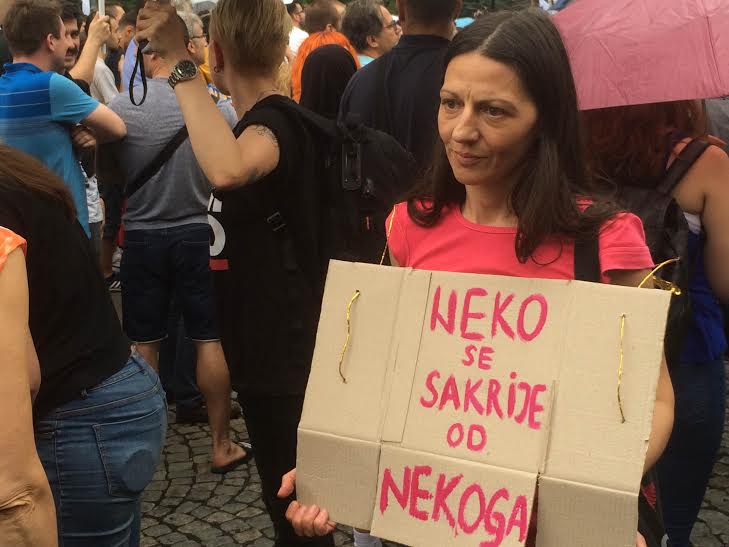
Many critics of the construction project, state that it is highly inappropriate for the city, especially for the old part Savamala, that emerges as the artistic area, but also because of the corrupt government deals in it. Information has leaked that the political figures of the ruling are directly related to the project Belgrade Waterfront. The development of the project over the past two years has been slow, says Pavle. “Every two or three months, a small part of buildings are destroyed in this old neighborhood in Belgrade. This includes moving large numbers of people, so everything happens step by step. I believe that if this movement creates a strategy in their resistance, it could force the government to reconsider Belgrade Waterfront.”
After the third consecutive large protest in the Serbian capital, the next one is expected to be in the usual two weeks. The invocations are strikingly sharp, and pierce the oldest buildings in Belgrade who sleep restlessly as if realizing that the fight below is for their own lives. All this is accompanied by the powerful sound of Rage Against the Machine and The Clash.






It is nice to see young people interested, passionate about the future of their city, their country even.
I wish the best for them but remind them of trying to avoid violence.